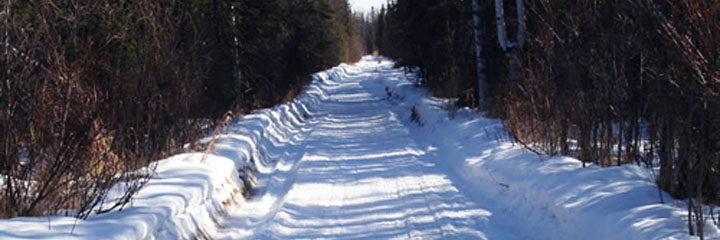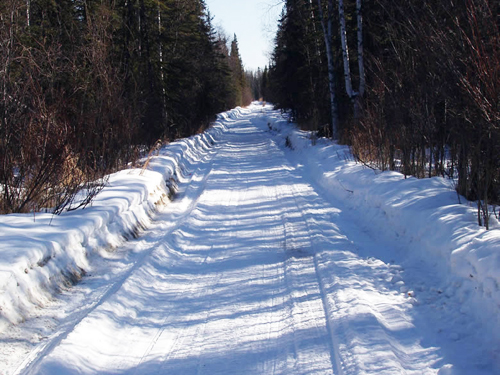Public Access Assertion and Defense
RS 2477 Trails Project

Background
Revised Statute 2477 (RS 2477) was a congressional grant of rights of way which provided: "The right of way for the construction of highways over public lands, not reserved for public uses, is hereby granted."
RS 2477 was repealed in 1976 which marked a dramatic change in federal land management policy. However, RS 2477 rights of way that existed at that date expressly remained as valid existing rights. As a result there are thousands of RS 2477 rights of way across the western United States and Alaska which, as congress intended, provided an important role in settling those areas. In Alaska, these rights of way continue to play an essential role in accessing Alaska's lands. To date, DNR has researched over 2,000 routes and determined that over 650 qualify under the RS 2477 statute.
What are RS 2477 Rights-of-Way?
RS 2477 was a self-executing grant, meaning that it grants required no formal process or action by the federal government, but rather the grant automatically took effect once certain conditions were met. A RS 2477 right of way comes into existence in Alaska automatically if a "public highway" was established across public lands according to Alaska law.
In order to complete the grant, there must have been an acceptance. Acceptance can take place either by a positive act on the part of the appropriate public authorities, clearly manifesting an intention to accept a grant or by public use for such a period of time and under such conditions as to indicate that the grant had been accepted. Expenditure of public money for construction or maintenance is often used as evidence of acceptance, but it is not required. If the facts show that the right of way was accepted while the underlying property was unreserved federally owned land, the federal government granted the right of way to the State of Alaska. The right of way is treated similar to an easement. The public has the right to use the right of way within the scope of the grant, but has no right to exceed that use. The underlying land owner may use the land in any fashion that does not interfere with the reasonable use of the right of way.
The underlying property owner may not restrict the "reasonable and necessary" use as measured in light of traditional uses and purposes of the right of way. Additionally, federal land managers may be able to "reasonably regulate" the right of way consistent with federal regulations within their jurisdiction. Use of the land outside the right of way or beyond its scope could constitute trespass on private land or violate local, state or federal regulations on public land. The RS 2477 right of way may be maintained, to the extent reasonably necessary to ensure safe use consistent with its intended purpose.
Any subsequent owner of land obtained from the federal government receives the property subject to a "valid existing right" in the RS 2477 right of way, regardless of when the State acquired its interest, or the right of way's present condition or use.
As a self-executing grant directly from Congress, a valid RS 2477 right of way cannot be vacated by federal land managers, though they may have some right to reasonably restrict the development and use of the right of way. However, federal managers have recently refused to acknowledge the existence of any RS 2477 on federal lands, unless it has been through a Quiet Title Action. This has clouded the State’s rights of access across federal lands.
A July 17, 2002 Attorney General Informal Opinion concluded: Alaska courts will apply state law to determine the scope of an RS 2477 right-of-way and will most likely apply the common law of easements applicable to private parties to decide the uses to which RS 2477 rights-of-way may be put. The allowable improvements to an RS 2477 right-of-way and the allowable uses thereof by the public will most likely be measured by that which is "reasonably necessary" in light of the historic uses made of the road before October 21, 1976. We believe Ninth Circuit precedent supports the application of state law to determine the scope of an RS 2477.
The RS 2477 Adjudication
Since 1993, the Department of Natural Resources (DNR) has received varying levels of funding to pursue the research and adjudication for RS 2477 rights-of-way. This project identifies routes throughout the state that appear to qualify as valid public rights-of-way under RS 2477. In recent years, Alaska court cases have determined the legal validity of RS 2477 routes. In the past, the status of most routes was typically uncontested and acknowledged to be legally valid under 43 USC 932 - RS 2477. To date the legislature has not codified additional RS 2477s adjudicated by the department. However, this does not make those adjudicated RS 2477 rights-of-way invalid. At this writing, additional routes are being studied and adjudicated for validity. This work will continue as funding and priorities allow.
To successfully document an RS 2477 right-of-way on a historic route, the route must be shown to have constructed or used when the land was unreserved federal land.
Typical route documentation includes:
- Alaska Road Commission annual reports and maps
- U.S. Geological Survey bulletins, reports, field notes, and maps
- U.S. Postal Service contracts, site reports, and maps
- Other publications (books, newspapers, magazines)
- Personal accounts (affidavits) are also valuable evidence of route use and construction.
If you have documentation that supports the validity of existing RS2477s or of routes you believe qualify as RS2477s, please submit that information to:
Alaska Department of Natural Resources
Public Access Assertion and Defense Unit
550 W. 7th Ave, Suite 1420
Anchorage, AK 99501
(907) 269-4755
If you need general information about RS 2477, the statute changes, or questions about a particular route, contact:
Alaska Department of Natural Resources
Public Information Center
550 W 7th Ave, Suite 1360
Anchorage, AK 99501
(907) 269-8400
Request For Trail Use Information
The State of Alaska Public Access Assertion and Defense needs your assistance to help preserve public access on Alaska roads and trails!
Do you have personal knowledge of historical use of any secondary or primitive road or trail in Alaska before 1968? If you have this knowledge, please share that information with us using the Alaska Trail Use Information Form
A sample of the information that we need is described below:
- Local name of the trail, if established.
- Provide the best trail description possible from one point to the next. Useful information would include section, township, range, meridian, USGS quadrangle map coordinates, survey or other geographical descriptions.
- Let us know if you have any supporting documentation such as photographs or maps that you would like to share with us. We may ask you to send a copy via mail or email.
- Identify what type of travel: by ATV, foot, dogsled, snow machines, trucks, etc.
- Describe why you used this trail (to get from point A to point B).
- Describe what activities were associated with the trail use: i.e., hunting, fishing, mining, subsistence, or other outdoor activities.
- Describe if the trail is used only in winter or summer or if the trail is used year-round.
- During what years did you use this trail? How many years of consistent use occurred on this trail?
- Also, please provide your name, mailing address and phone number so that we may contact you for further information.
Thank you for helping us strive to keep public access open on Alaskan trails!

